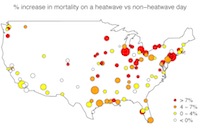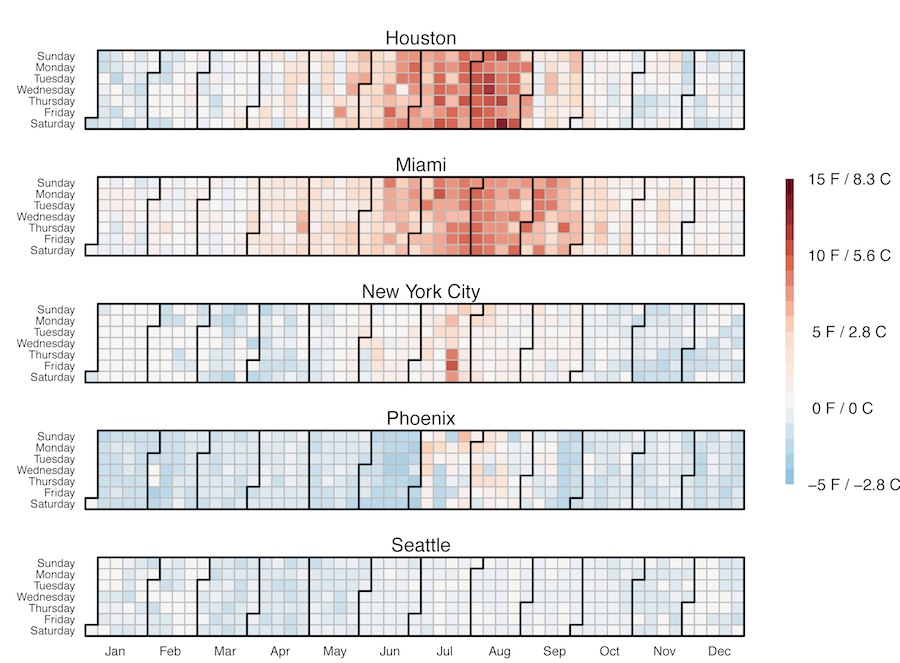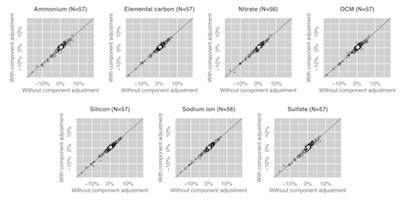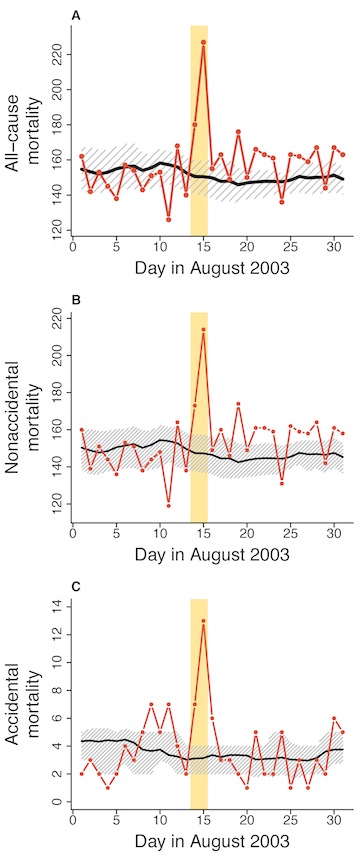Research
Overview
 My research explores how ambient environmental exposures, including
heat waves and air pollution, affect human health, particularly risks of
death and morbidity from common causes like cardiorespiratory
outcomes.
My research explores how ambient environmental exposures, including
heat waves and air pollution, affect human health, particularly risks of
death and morbidity from common causes like cardiorespiratory
outcomes.
I conduct multi-city studies that combine methods from time series analysis and episode analysis to investigate these risks across the United States. By jointly investigating impacts across many communities and pooling results with hierarchical modeling, these studies can identify important health impacts while accounting for variability in baseline health risk.
In current research, I am investigating the impacts of hurricanes and other tropical storms on cardiorespiratory mortality risk in over 30 US cities. As part of this research, I am collaborating with environmental engineers to determine how infrastructure damages, like power outages and road closures, modify the health impacts of climatological natural disasters.
Outdoor Temperature
 Heat waves can have catastrophic public health impacts. For example,
all-cause mortality approximately doubled during severe heat waves in
Chicago in 1995 and in parts of France in 2003. With climate change, heat waves are
expected to become more frequent and severe.
Heat waves can have catastrophic public health impacts. For example,
all-cause mortality approximately doubled during severe heat waves in
Chicago in 1995 and in parts of France in 2003. With climate change, heat waves are
expected to become more frequent and severe.
For my dissertation, I investigated the impacts of hot and cold temperatures, as well as heat waves, on cardiorespiratory mortality risk across the United States. My research identified substantial mortality risk following extreme temperatures, especially in places where these extremes are unusual (for example, the Northeast and Midwest for heat impacts, the South for cold impacts). I also examined how heat wave characteristics- including heat wave length, average temperature, and timing in the summer- modify health risks.
In current research, I am quantifying the impacts of extreme temperatures on emergency hospitalization rates across the United States. I am also reviewing the use of heat index (the "feels like" temperature) as a metric of heat exposure and have written software to calculate the heat index in the R statistical package using the US National Weather Service's algorithm.
Publications
- G. Brooke Anderson and Michelle L. Bell. 2009. Weather-related mortality: How heat, cold and heat waves affect mortality in the United States. Epidemiology. 20(2):205-213.
- G. Brooke Anderson and Michelle L. Bell. 2011. Heat waves in the United States: Mortality risk during heat waves and effect modification by heat wave characteristics in 43 U.S. communities Environmental Health Perspectives. 119(2):210-218.
- Jiyoung Son, Jong-Tae Lee, G. Brooke Anderson, and Michelle L. Bell. 2011. Vulnerability to temperature-related mortality in Seoul, Korea. Environmental Research Letters. 6:doi:10.1088/1748-9326/6/3/034027
- Jiyoung Son, Jong-Tae Lee, G. Brooke Anderson, and Michelle L. Bell. 2012. The impact of heat waves on mortality in 7 major cities in Korea. Environmental Health Perspectives. 120(4):566–571.
- G. Brooke Anderson, Michelle L. Bell, and Roger D. Peng. Methods to calculate the heat index as an exposure metric in environmental health research. Submitted for publication.
- G. Brooke Anderson, Francesca Dominici, Yun Wang, Meredith McCormack, Michelle L. Bell, and Roger D. Peng. Heat-related emergency hospitalizations for respiratory diseases in the Medicare population. Submitted for publication.
Ambient Air Pollution
 Ambient air pollution, including tropospheric ozone pollution and
particulate matter pollution, has been found to increase risk of human
mortality and morbidity. I have collaborated with researchers at Yale
University, Johns Hopkins Bloomberg School of Public Health, and Harvard
School of Public Health to investigate the impacts of ozone and
particulate matter pollution on cardiorespiratory mortality.
Ambient air pollution, including tropospheric ozone pollution and
particulate matter pollution, has been found to increase risk of human
mortality and morbidity. I have collaborated with researchers at Yale
University, Johns Hopkins Bloomberg School of Public Health, and Harvard
School of Public Health to investigate the impacts of ozone and
particulate matter pollution on cardiorespiratory mortality.
In particular, I led one project that determined that the association between ozone pollution and cardiorespiratory mortality is not confounded by seven key chemical components of particulate matter, and I am collaborating on another project that investigates the direct impacts of particulate matter components on human mortality across the United States. In addition to this health research, I have also investigated the standard ratios used to convert between ozone exposure metrics and used national ozone concentration data to determine appropriate ratios for these conversions.
Publications
- G. Brooke Anderson and Michelle L. Bell. 2010. Does one size fit all? The suitability of standard ozone exposure metric conversion ratios and implications for epidemiology. Journal of Exposure Science and Environmental Epidemiology. 20:2-11.
- G. Brooke Anderson, Jenna R. Krall, Roger D. Peng, and Michelle L. Bell. 2012. Is the relation between ozone and mortality confounded by chemical components of particulate matter? Analysis of 7 components in 57 US communities. American Journal of Epidemiology. 176(8):726-732.
- Jenna R. Krall, Michelle L. Bell, G. Brooke Anderson, Francesca Dominici, and Roger D. Peng. Mortality effects of particulate matter constituents in a national study of U.S. urban communities. Submitted for publication.
2003 Northeastern Blackout
 Power outages are common and are likely to become more common as
climate change increases the severity of heat waves and other
climatological natural disasters. However, little is known about how
power outages impact health risks from common causes, like heart attacks
and respiratory events.
Power outages are common and are likely to become more common as
climate change increases the severity of heat waves and other
climatological natural disasters. However, little is known about how
power outages impact health risks from common causes, like heart attacks
and respiratory events.
I conducted a study that investigated all-cause mortality risk during the 2003 Northeastern blackout in New York, NY, the first citywide blackout of New York since the 1970s. This study identified approximately 90 excess deaths during the blackout compared to expected mortality rates had the blackout not occured. Most of these deaths were from non-accidental causes, rather than from accidental causes like carbon monoxide poisoning more commonly considered important health threats during power outages.
Publication
Current and Future Research
Currently, I am investigating how hurricanes and other tropical storms affected all-cause mortality risk in 38 US cities over 19 years. As part of this research, I will work with environmental engineers to determine how infrastructure damage during these storms, including power outages and road closures, modify health risks. I am also continuing to study the health impacts of extreme outdoor temperatures by quantifying temperature's effect on emergency hospitalization rates throughout the US.
In the future, I plan to use the health risk estimates developed in my current projects to predict future health risks from climatological natural disasters, like heat waves and hurricanes, under climate change scenarios. I also plan to continue my current focus on the interplay of climatological disasters, infrastructure damage, and human health impacts through continued collaborations with researchers in Civil and Environmental Engineering.